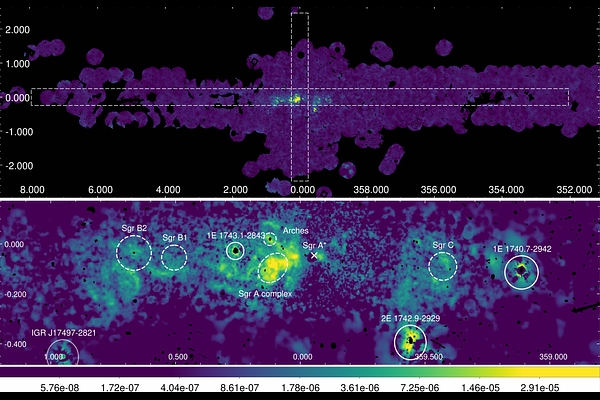Disentangling the Galactic centre X-ray reflection signal using XMM-Newton data

Disentangling the Galactic centre X-ray reflection signal using XMM-Newton data
K. Anastasopoulou, I. Khabibullin, E. Churazov, G. Ponti, M. C. Sormani, R. A. Sunyaev, C. Maitra, S. Piscitelli
AbstractWe investigate the X-ray emission from the Galactic Centre (GC) region, focusing on the 6.4 keV fluorescent line of neutral or weakly ionised iron, which is commonly attributed to X-ray reflection from dense molecular clouds. Our goal is to separate the reflection signal from other physical X-ray components. We aim to produce a clean map of the 6.4 keV emission, thus providing a better understanding of the X-ray reflection processes in the GC. We utilised a deep mosaic of all available XMM-Newton observations, encompassing the central 40 square degrees of the Galaxy. The mosaics of two narrow bands centred at 6.7 keV and 6.4 keV, and a broader continuum band at lower energies (5-6.1 keV), provided valuable spatial and spectral information on the X-ray emission. These combined with the stellar mass distribution of our Galaxy enabled us to decompose the observed signal into physically meaningful components. Our analysis shows that the cleaned 6.4 keV band map, free from the contribution of bright and unresolved point sources, is predominantly shaped by X-ray reflection from dense molecular clouds. The spatial distribution of this emission, which strongly correlates with the molecular gas distribution in the Central Molecular Zone (CMZ), supports the interpretation that this map provides the best estimate of the X-ray reflection signal averaged over the last two decades. The cleaned reflection map produced could serve as a tool for future studies to quantify upper limits on the reflection contribution from low-energy cosmic rays in unilluminated regions. Moreover, we estimate that, on average within the CMZ, approximately 65% of the ridge emission contributes to the observed 6.4 keV emission, a factor that should be incorporated into upcoming investigations of the GC, such as polarisation studies of the reflected X-ray continuum from molecular clouds.